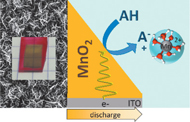Publication
906
Adv. Energy Mater., 10 (23), 2000332, 2020
DOI:10.1002/aenm.202000332
|
|
|
|
|
|

|
Accessing the Two-Electron Charge Storage Capacity of MnO2 in Mild Aqueous Electrolytes |
|
|
|
Mickaël Mateos, Nikolina Makivic, Yee-Seul Kim, Benoît Limoges, and Véronique Balland
Université de Paris, Laboratoire d’Electrochimie Moléculaire, CNRS, F-75013 Paris, France
Rechargeable batteries based on MnO2 cathodes, able to operate in mild aqueous electrolytes, have attracted attention due to their appealing features for the design of low-cost stationary energy storage devices. However, the charge/discharge mechanism of MnO2 in such media is still a matter of debate. Here, an in-depth quantitative spectroelectrochemical analysis of MnO2 thin-films provides a set of unrivaled mechanistic insights. A major finding is that charge storage occurs through the reversible two-electron faradaic conversion of MnO2 into Mn2+ in the presence of a wide range of weak Brønsted acids, including the [Zn(H2O)6]2+ or [Mn(H2O)6]2+ complexes present in aqueous Zn/MnO2 batteries. Furthermore, it is shown that buffered electrolytes loaded with Mn2+ are ideal to achieve highly reversible conversion of MnO2 with both high gravimetric capacity and remarkably stable charging/discharging potentials. In the most favorable case, a record gravimetric capacity of 450 mA·h·g-1 is obtained at a high rate of 1.6 A·g-1, with a Coulombic efficiency close to 100% and a MnO2 utilization of 84%. Overall, the present results challenge the common view on MnO2 the charge storage mechanism in mild aqueous electrolytes and underline the benefit of buffered electrolytes for high-performance rechargeable aqueous batteries. |

